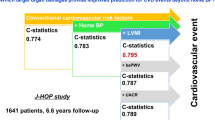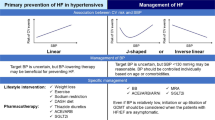Abstract
It remains unclear whether cumulative blood pressure (BP) exposure is associated with adverse outcomes in heart failure with preserved ejection fraction (HFpEF). The aim was to investigate the associations of adverse health outcomes with cumulative BP exposure as captured by weighted BP, cumulative BP and trends in BP over a 1-year timespan from baseline to a 12-month visit among 1303 patients with HFpEF (49.5% women; mean age, 71.5 years) enrolled in the TOPCAT (Treatment of Preserved Cardiac Function Heart Failure with an Aldosterone Antagonist) trial. The primary endpoints consisted of death from cardiovascular causes, aborted cardiac arrest, or hospitalization for the management of heart failure.We computed hazard ratios with a 1-SD increase in weighted BP and cumulative BP. In the spironolactone group, compared with patients with a downward trend in BP, those with an upward trend had higher event rates. However, there were no differences in event rates between those with upward and downward trends in BP in the placebo group. In multivariable-adjusted analyses that additionally accounted for baseline BP, weighted systolic BP and cumulative systolic BP predicted (P ≤ 0.037) the primary composite endpoint (hazard ratio [HR], 1.21; 95% CI, 1.05-1.39/1.15; 1.01-1.31) and hospitalization for HF (1.29; 1.09-1.52/1.18; 1.02-1.37), respectively. Among patients aged ≤72 years, cumulative systolic BP increased (P ≤ 0.016) the risk of the primary endpoint and hospitalization for HF. Higher cumulative systolic BP exposure conferred a higher risk of the primary endpoint and hospitalization for HF, independent of baseline BP. Our findings underscore that longitudinal BP measurements may refine risk stratification for patients with HFpEF.
This is a preview of subscription content, access via your institution
Access options
Subscribe to this journal
Receive 12 print issues and online access
$259.00 per year
only $21.58 per issue
Buy this article
- Purchase on Springer Link
- Instant access to full article PDF
Prices may be subject to local taxes which are calculated during checkout


Similar content being viewed by others
References
NCD Risk Factor Collaboration. Worldwide trends in hypertension prevalence and progress in treatment and control from 1990 to 2019: a pooled analysis of 1201 population-representative studies with 104 million participants. Lancet. 2021;398:957–80.
Unger T, Borghi C, Charchar F, Khan NA, Poulter NR, Prabhakaran D, et al. 2020 International Society of Hypertension Global Hypertension Practice Guidelines. Hypertension. 2020;75:1334–57.
Global Burden of Disease Risk Factor Collaborators. Global, regional, and national comparative risk assessment of 84 behavioural, environmental and occupational, and metabolic risks or clusters of risks for 195 countries and territories, 1990–2017: a systematic analysis for the Global Burden of Disease Study 2017. Lancet. 2018;392:1923–94.
Petruski-Ivleva N, Viera AJ, Shimbo D, Muntner P, Avery CL, Schneider AL, et al. Longitudinal patterns of change in systolic blood pressure and incidence of cardiovascular disease: the atherosclerosis risk in communities study. Hypertension. 2016;67:1150–6.
Pool LR, Ning H, Wilkins J, Lloyd-Jones DM, Allen NB. Use of long-term cumulative blood pressure in cardiovascular risk prediction models. JAMA Cardiol. 2018;3:1096–1100.
Ayala Solares JR, Canoy D, Raimondi FED, Zhu Y, Hassaine A, Salimi-Khorshidi G, et al. Long-term exposure to elevated systolic blood pressure in predicting incident cardiovascular disease: evidence from large-scale routine electronic health records. J Am Heart Assoc. 2019;8:e012129.
Nuotio J, Suvila K, Cheng S, Langén V, Niiranen T. Longitudinal blood presusre patterns and cardiocvascular disease risk. Ann Med. 2020;52:43–54.
Nwabuo CC, Appiah D, Moreira HT, Vasconcellos HD, Yano Y, Reis JP, et al. Long-term cumulative blood pressure in young adults and incident heart failure, coronary heart disease, stroke, and cardiovascular disease: The CARDIA study. Eur J Prev Cardiol. 2021;28:1445–51.
Kishi S, Teixido-Tura G, Ning H, Venkatesh BA, Wu C, Almeida A, et al. Cumulative blood pressure in early adulthood and cardiac dysfunction in middle age: the CARDIA study. J Am Coll Cardiol. 2015;65:2679–87.
Vasconcellos HD, Moreira HT, Ciuffo L, Nwabuo CC, Yared GS, Ambale-Venkatesh B, et al. Cumulative blood pressure from early adulthood to middle age is associated with left atrial remodelling and subclinical dysfunction assessed by three-dimensional echocardiography: a prospective post hoc analysis from the coronary artery risk development in young adults study. Eur Heart J Cardiovasc Imaging. 2018;19:977–84.
Kramer H, Colangelo L, Lewis CE, Jacobs DR Jr, Pletcher M, Bibbins-Domingo K, et al. Cumulative exposure to systolic blood pressure during young adulthood through midlife and the urine albumin-to-creatinine ratio at midlife. Am J Hypertens. 2017;30:502–9.
Teramoto K, Nadruz Junior W, Matsushita K, Claggett B, John JE, Skali H, et al. Mid- to late-life time-averaged cumulative blood pressure and late-life cardiac structure, function, and heart failure. Hypertension 2020;76:808–18.
Chaput de Saintonge DM, Vere DW. Why don’t doctors use cusums? Lancet 1974;1:120–1.
Stanton A, Cox J, Atkins N, O’Malley K, O’Brien E. Cumulative sums in quantifying circadian blood pressure patterns. Hypertension 1992;19:93–101.
Wizner B, Dechering DG, Thijs L, Atkins N, Fagard R, O’Brien E, et al. Short-term and long-term repeatability of the morning blood pressure in older patients with isolated systolic hypertension. J Hypertens. 2008;26:1328–35.
Conrad N, Judge A, Tran J, Mohseni H, Hedgecott D, Crespillo AP, et al. Temporal trends and patterns in heart failure incidence: a population-based study of 4 million individuals. Lancet 2018;391:572–80.
Paulus WJ, Tschope C. A novel paradigm for heart failure with preserved ejection fraction: comorbidities drive myocardial dysfunction and remodeling through coronary microvascular endothelial inflammation. J Am Coll Cardiol. 2013;62:263–71.
Owan TE, Hodge DO, Herges RM, Jacobsen SJ, Roger VL, Redfield MM. Trends in prevalence and outcome of heart failure with preserved ejection fraction. N. Engl J Med. 2006;355:251–9.
Shahim A, Hourqueig M, Donal E, Oger E, Venkateshvaran A, Daubert JC, et al. Predictors of long-term outcome in heart failure with preserved ejection fraction: a follow-up from the KaRen study. ESC Heart Fail 2021;8:4243–54.
Pitt B, Pfeffer MA, Assmann SF, Boineau R, Anand IS, Claggett B, et al. Spironolactone for heart failure with preserved ejection fraction. N Engl J Med. 2014;370:1383–92.
Shah AM, Shah SJ, Anand IS, Sweitzer NK, O’Meara E, Heitner JF, et al. Cardiac structure and function in heart failure with preserved ejection fraction: baseline findings from the echocardiographic study of the Treatment of Preserved Cardiac Function Heart Failure with an Aldosterone Antagonist trial. Circ Heart Fail. 2014;7:104–15.
World Medical Association. World Medical Association Declaration of Helsinki: ethical principles for medical research involving human subjects. JAMA. 2013;310:2191–4.
Wei FF, Li Y, Zhang L, Xu TY, Ding FH, Wang JG, et al. Beat-to-beat, reading-to-reading, and day-to-day blood pressure variability in relation to organ damage in untreated Chinese. Hypertension. 2014;63:790–6.
O’Brien E, Perry I, Sheridan J, Atkins N, O’Malley K. Application of cusums to ambulatory blood pressure data: a simple statistical technique for detecting trends over time. J Hypertens. 1989;7:707–9.
Solomon SD, Claggett B, Lewis EF, Desai A, Anand I, Sweitzer NK, et al. Influence of ejection fraction on outcomes and efficacy of spironolactone in patients with heart failure with preserved ejection fraction. Eur Heart J. 2016;37:455–62.
Wei FF, Wu Y, Xue R, Liu X, He X, Dong B, et al. Clinical significance of mean and pulse pressure in patients with heart failure with preserved ejection fraction. Hypertension 2022;79:241–50.
Lai CC, Sun D, Cen R, Wang J, Li S, Fernandez-Alonso C, et al. Impact of long-term burden of excessive adiposity and elevated blood pressure from childhood on adulthood left ventricular remodeling patterns: the Bogalusa Heart Study. J Am Coll Cardiol. 2014;64:1580–7.
Sasai H, Sairenchi T, Irie F, Otaka E, Iso H, Tanaka K, et al. Long-term exposure to elevated blood pressure and mortality from cardiovascular disease in a Japanese population: the Ibaraki Prefectural Health Study. Hypertens Res. 2011;34:139–44.
Zemaitis P, Liu K, Jacobs DR Jr, Cushman M, Durazo-Arvizu R, Shoham D, et al. Cumulative systolic BP and changes in urine albumin-to-creatinine ratios in nondiabetic participants of the multi-ethnic study of atherosclerosis. Clin J Am Soc Nephrol. 2014;9:1922–9.
Reges O, Ning H, Wilkins JT, Wu CO, Tian X, Domanski MJ, et al. Association of cumulative systolic blood pressure with long-term risk of cardiovascular disease and healthy longevity: findings from the lifetime risk pooling project cohorts. Hypertension 2021;77:347–56.
Acknowledgements
We thank the TOPCAT (Treatment of Preserved Cardiac Function Heart Failure with an Aldosterone Antagonist) trial investigators for conducting this trial and making these data available.
Funding
This article was supported by the National Natural Science Foundation of China (81770392, 81770394, 81700344, 81800344, 81800345, and 82000372), Guangdong Natural Science Foundation (2016A030310180, 2017A030310311, and 2017A030313795), Science and Technology Program Foundation of Guangzhou (201610010125 and 201707010124), Science and Technology Program Foundation of Guangdong (2017A020215156), Medical Research Foundation of Guangdong Province (A2018107 and A2018082), and China Postdoctoral Science Foundation (2019M663312). The NPA Alliance for the Promotion of Preventive Medicine (APPREMED), Mechelen, Belgium, received a nonbinding grant from OMRON Healthcare, Co., Ltd., Kyoto, Japan. The TOPCAT (Treatment of Preserved Cardiac Function Heart Failure with an Aldosterone Antagonist) trial was funded by the National Institutes of Health National Heart, Lung, and Blood Institute (NHLBI), Bethesda, MD (N01 HC45207). This article was prepared using TOPCAT research materials obtained from the NHLBI Biologic Specimen and Data Repository Information Coordinating Center and does not necessarily reflect the opinions or views of the TOPCAT investigators or the NHLBI.
Author information
Authors and Affiliations
Contributions
F-FW, JAS and CL designed the study. F-FW, YZ, YW and CL conducted the data analysis and drafted the manuscript. All authors provided substantial contributions to the interpretation of the results and revision of the manuscript. All authors gave final approval and agreed to be accountable for all aspects of the work ensuring integrity and accuracy. The corresponding authors attest that all the listed authors meet the authorship criteria.
Corresponding authors
Ethics declarations
Conflict of interest
The authors declare no competing interests.
Additional information
Publisher’s note Springer Nature remains neutral with regard to jurisdictional claims in published maps and institutional affiliations.
Supplementary information
Rights and permissions
Springer Nature or its licensor (e.g. a society or other partner) holds exclusive rights to this article under a publishing agreement with the author(s) or other rightsholder(s); author self-archiving of the accepted manuscript version of this article is solely governed by the terms of such publishing agreement and applicable law.
About this article
Cite this article
Wei, FF., Zhou, Y., Wu, Y. et al. Clinical information from repeated blood pressure measurements in the management of heart failure with preserved ejection fraction. Hypertens Res 46, 475–484 (2023). https://doi.org/10.1038/s41440-022-01079-9
Received:
Revised:
Accepted:
Published:
Issue Date:
DOI: https://doi.org/10.1038/s41440-022-01079-9
Keywords
This article is cited by
-
2023 update and perspectives
Hypertension Research (2024)



